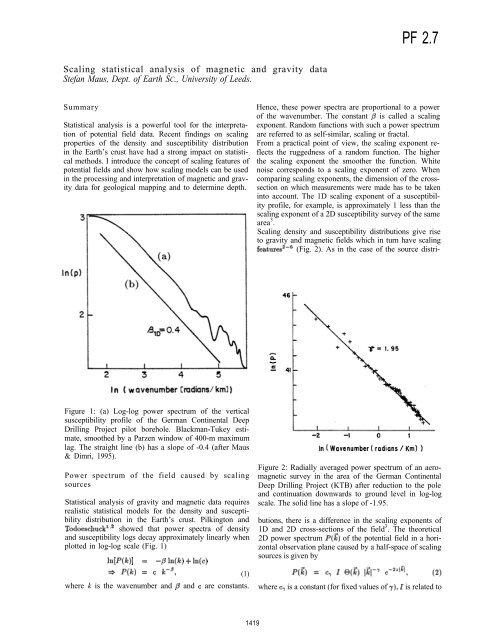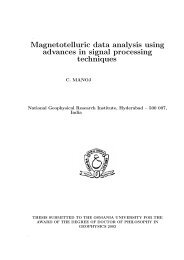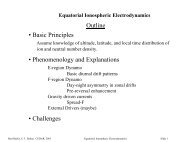Scaling statistical analysis of magnetic and gravity data
Scaling statistical analysis of magnetic and gravity data
Scaling statistical analysis of magnetic and gravity data
Create successful ePaper yourself
Turn your PDF publications into a flip-book with our unique Google optimized e-Paper software.
<strong>Scaling</strong> <strong>statistical</strong> <strong>analysis</strong> <strong>of</strong> <strong>magnetic</strong> <strong>and</strong> <strong>gravity</strong> <strong>data</strong><br />
Stefan Maus, Dept. <strong>of</strong> Earth SC., University <strong>of</strong> Leeds.<br />
Summary<br />
Statistical <strong>analysis</strong> is a powerful tool for the interpretation<br />
<strong>of</strong> potential field <strong>data</strong>. Recent findings on scaling<br />
properties <strong>of</strong> the density <strong>and</strong> susceptibility distribution<br />
in the Earth’s crust have had a strong impact on <strong>statistical</strong><br />
methods. I introduce the concept <strong>of</strong> scaling features <strong>of</strong><br />
potential fields <strong>and</strong> show how scaling models can be used<br />
in the processing <strong>and</strong> interpretation <strong>of</strong> <strong>magnetic</strong> <strong>and</strong> <strong>gravity</strong><br />
<strong>data</strong> for geological mapping <strong>and</strong> to determine depth.<br />
Figure 1: (a) Log-log power spectrum <strong>of</strong> the vertical<br />
susceptibility pr<strong>of</strong>ile <strong>of</strong> the German Continental Deep<br />
Drilling Project pilot borehole. Blackman-Tukey estimate,<br />
smoothed by a Parzen window <strong>of</strong> 400-m maximum<br />
lag. The straight line (b) has a slope <strong>of</strong> -0.4 (after Maus<br />
& Dimri, 1995).<br />
Power spectrum <strong>of</strong> the field caused by scaling<br />
sources<br />
Statistical <strong>analysis</strong> <strong>of</strong> <strong>gravity</strong> <strong>and</strong> <strong>magnetic</strong> <strong>data</strong> requires<br />
realistic <strong>statistical</strong> models for the density <strong>and</strong> susceptibility<br />
distribution in the Earth’s crust. Pilkington <strong>and</strong><br />
showed that power spectra <strong>of</strong> density<br />
<strong>and</strong> susceptibility logs decay approximately linearly when<br />
plotted in log-log scale (Fig. 1)<br />
PF 2.7<br />
Hence, these power spectra are proportional to a power<br />
<strong>of</strong> the wavenumber. The constant is called a scaling<br />
exponent. R<strong>and</strong>om functions with such a power spectrum<br />
are referred to as self-similar, scaling or fractal.<br />
From a practical point <strong>of</strong> view, the scaling exponent reflects<br />
the ruggedness <strong>of</strong> a r<strong>and</strong>om function. The higher<br />
the scaling exponent the smoother the function. White<br />
noise corresponds to a scaling exponent <strong>of</strong> zero. When<br />
comparing scaling exponents, the dimension <strong>of</strong> the crosssection<br />
on which measurements were made has to be taken<br />
into account. The 1D scaling exponent <strong>of</strong> a susceptibility<br />
pr<strong>of</strong>ile, for example, is approximately 1 less than the<br />
scaling exponent <strong>of</strong> a 2D susceptibility survey <strong>of</strong> the same<br />
area 3 .<br />
<strong>Scaling</strong> density <strong>and</strong> susceptibility distributions give rise<br />
to <strong>gravity</strong> <strong>and</strong> <strong>magnetic</strong> fields which in turn have scaling<br />
(Fig. 2). As in the case <strong>of</strong> the source distri-<br />
Figure 2: Radially averaged power spectrum <strong>of</strong> an aero<strong>magnetic</strong><br />
survey in the area <strong>of</strong> the German Continental<br />
Deep Drilling Project (KTB) after reduction to the pole<br />
<strong>and</strong> continuation downwards to ground level in log-log<br />
scale. The solid line has a slope <strong>of</strong> -1.95.<br />
butions, there is a difference in the scaling exponents <strong>of</strong><br />
1D <strong>and</strong> 2D cross-sections <strong>of</strong> the field 3 . The theoretical<br />
2D power spectrum <strong>of</strong> the potential field in a horizontal<br />
observation plane caused by a half-space <strong>of</strong> scaling<br />
sources is given by<br />
(1)<br />
where k is the wavenumber <strong>and</strong> <strong>and</strong> are constants. where is a constant (for fixed values <strong>of</strong> is related to<br />
1419
Figure 3: Radially averaged log power spectrum <strong>of</strong> the<br />
KTB aero<strong>magnetic</strong> survey. The solid line indicates the<br />
model power spectrum for 19.23, = <strong>and</strong><br />
= 2.07 (after Maus & Dimri, 1995).<br />
the intensity <strong>of</strong> density or susceptibility variations,<br />
reflects the anisotropy <strong>of</strong> the <strong>magnetic</strong> field (for the <strong>gravity</strong><br />
field is the scaling exponent <strong>of</strong> the field<br />
<strong>and</strong> is the distance between the observation plane <strong>and</strong><br />
the top <strong>of</strong> the model half-space. Fig. 3 shows the fit <strong>of</strong><br />
the model power spectrum defined by eq. (2) to the power<br />
spectrum <strong>of</strong> a real aero<strong>magnetic</strong> <strong>data</strong> set. In this case the<br />
radially averaged power spectrum was used. However,<br />
radial averaging leads to a loss <strong>of</strong> information <strong>and</strong> future<br />
methods are likely to use the original 2D power spectrum,<br />
instead.<br />
Applications<br />
The model power spectrum defined by eq. (2) is governed<br />
by three parameters, <strong>and</strong> which can be derived by<br />
<strong>statistical</strong> <strong>analysis</strong> <strong>of</strong> a survey <strong>and</strong> can subsequently be<br />
displayed as maps. All three parameters describe different<br />
aspects <strong>of</strong> the <strong>gravity</strong> or <strong>magnetic</strong> field.<br />
The depth to the top <strong>of</strong> the sources is particularly interesting<br />
in the study <strong>of</strong> sedimentary basins, where it may<br />
reflect the depth to the crystalline basement or the depth<br />
to certain intra-basin geological structures.<br />
The Intensity quantifies the amplitude <strong>of</strong> susceptibility<br />
<strong>and</strong> density variations while taking into account the distance<br />
<strong>of</strong> the sources from the observation plane. Hence,<br />
the parameter can be high even for a weak field anomaly,<br />
if the depth to the source anomaly is high at the same<br />
<strong>Scaling</strong> <strong>statistical</strong> <strong>analysis</strong><br />
1420<br />
Figure 4: A window is moved over the survey area. For<br />
every position <strong>of</strong> the window an inversion is carried out<br />
using the <strong>data</strong> within the window. Here, the resulting<br />
depths to source are displayed as a pr<strong>of</strong>ile.<br />
time. A further attractive feature <strong>of</strong> the parameter is<br />
that it can be derived from <strong>magnetic</strong> <strong>data</strong> without a reduction<br />
to the pole.<br />
The third parameter, the scaling exponent reflects <strong>statistical</strong><br />
properties <strong>of</strong> the source distributions. As discussed<br />
below, it may be useful in separating different<br />
types <strong>of</strong> geology, such as volcanic from metamorphic, or<br />
Recent from Precambrian.<br />
The optimum values for these parameters are obtained<br />
by inversion. An appropriately sized ‘window is moved<br />
over the <strong>data</strong> set (Fig. 4), <strong>and</strong> an inversion <strong>of</strong> the <strong>data</strong><br />
within the window is carried out to derive the best values<br />
for <strong>and</strong> at every position <strong>of</strong> the window. The<br />
values for subsequent inversions (= window positions) can<br />
then be plotted as pr<strong>of</strong>iles (Fig. 4 & 5), or as maps <strong>of</strong><br />
the particular parameter. However, due to a trade-<strong>of</strong>f<br />
between the scaling exponent <strong>and</strong> the depth to source<br />
only one <strong>of</strong> these two parameters can be resolved at a<br />
time.<br />
To obtain the depth to source, a constant scaling exponent<br />
has shown to be a reasonable assumption in areas<br />
without major changes in the geology <strong>of</strong> the basement.<br />
Pilkington <strong>and</strong> Todoeschuck 7 used a value <strong>of</strong> = 3, while<br />
7 = 2 was used in another case study 8 (Fig. 4 & 5). Using<br />
a lower scaling exponent leads to greater depth estimates<br />
<strong>and</strong> vice-versa. Thus, the method can be calibrated by<br />
choosing the scaling exponent in such a way that the inversion<br />
yields the correct depth to source for a window<br />
with known basement depth.<br />
If, on the other h<strong>and</strong>, the area has outcropping sources
Figure 5: The <strong>magnetic</strong> pr<strong>of</strong>iles used for the inversion are<br />
plotted together in the top graph. The <strong>statistical</strong> method<br />
quantifies the ruggedness <strong>of</strong> these pr<strong>of</strong>iles in terms <strong>of</strong> the<br />
scaling exponent <strong>and</strong> the depth to source, whereas the<br />
amplitude <strong>of</strong> the field is reflected in the source intensity.<br />
For this particular study the scaling exponent was kept<br />
constant at = 2.<br />
<strong>Scaling</strong> <strong>statistical</strong> <strong>analysis</strong><br />
then the depth to the top <strong>of</strong> the sources is known to be<br />
the survey terrain clearance. In this case one can derive<br />
maps <strong>of</strong> the Intensity <strong>and</strong> the scaling exponent Fig. 6<br />
shows a pr<strong>of</strong>ile <strong>of</strong> the scaling exponent over an area with<br />
outcropping <strong>magnetic</strong> rocks. It correlates well with the<br />
surface geology. The variations <strong>of</strong> the scaling exponent<br />
are thought to indicate differences in the distribution <strong>of</strong><br />
<strong>magnetic</strong> minerals within the geological units”.<br />
Conclusions <strong>and</strong> outlook<br />
<strong>Scaling</strong> source models have lead to a new underst<strong>and</strong>ing <strong>of</strong><br />
the power spectrum <strong>of</strong> <strong>gravity</strong> <strong>and</strong> <strong>magnetic</strong> <strong>data</strong>. They<br />
have made it possible to map the topography <strong>of</strong> a crystalline<br />
basement covered by non<strong>magnetic</strong> sediments with<br />
increased precision’. As a by-product, a map <strong>of</strong> the intensity<br />
<strong>of</strong> magnetization <strong>of</strong> the basement can be obtained.<br />
For areas with outcropping sources, maps <strong>of</strong> the intensity<br />
<strong>and</strong> the scaling exponent <strong>of</strong> the source variations can<br />
be derived. Although this has so far only been tried for<br />
<strong>magnetic</strong> <strong>data</strong> 5 , it may in fact be an attractive way <strong>of</strong><br />
displaying <strong>gravity</strong> <strong>data</strong>.<br />
Many <strong>of</strong> the theoretical questions regarding scaling features<br />
<strong>of</strong> potential fields are now quite well understood.<br />
Hence, the next step should be to develop efficient algorithms<br />
for high resolution mapping <strong>of</strong> the scaling parame-<br />
1421<br />
Figure 6: A SW-NE pr<strong>of</strong>ile <strong>of</strong> the scaling exponent in<br />
the area <strong>of</strong> the German Continental Deep Drilling Project<br />
(KTB) with a cartoon <strong>of</strong> the geological section. The Franconian<br />
line, a major vertical fault, is indicated by FL (after<br />
Maus & Dimri, 1995).<br />
ters <strong>and</strong> Existing methods <strong>of</strong> spectral <strong>analysis</strong> can<br />
be improved by using an anisotropic 2D spectral model,<br />
instead <strong>of</strong> the radially averaged power spectrum. Furthermore,<br />
the loss <strong>of</strong> information during gridding can be<br />
avoided by estimating power spectra directly from the<br />
original point-located <strong>data</strong>.<br />
References<br />
[l]Pilkington, M., <strong>and</strong> J. P. Todoeschuck, Stochastic inversion<br />
for scaling geology, Geophys. J. Int., 102, 205-217,1990.<br />
[2] Pilkington, M. <strong>and</strong> J. P. Todoeschuck, Fractal magnetization<br />
<strong>of</strong> continental crust, Geophys. Res. Lett., 20, 627,630,<br />
1993.<br />
[3] Maus, S., <strong>and</strong> V. P. Dimri, <strong>Scaling</strong> properties <strong>of</strong> potential<br />
fields due to scaling sources, Geophys. Res. Lett., 21,891.894,<br />
1994.<br />
[4] Gregotski, M. E., 0. G. Jensen, <strong>and</strong> J. Arkani-Hamed, Fractal<br />
stochastic modeling <strong>of</strong> aero<strong>magnetic</strong> <strong>data</strong>, Geophysics, 56,<br />
1706-1715,1991.<br />
[5] Maus, S. <strong>and</strong> V. P. Dimri, Potential field power spectrum inversion<br />
for scaling geology, J. Geophys. Res., 100, B7, 12605-<br />
12616,1995.<br />
[6] Maus, S. <strong>and</strong> V.P. Dimri, Depth estimation from the scaling<br />
power spectrum <strong>of</strong> potential fields? Geophys. J. Int. 124,113.<br />
120 (1996).<br />
[7] Pilkington, M., M. E. Gregotski, <strong>and</strong> J. P. Todoeschuck,<br />
Using fractal crustal magnetization models in <strong>magnetic</strong> interpretation,<br />
Geophys. Prospect., 42, 677.692,1994.<br />
[8] Maus, S., K.P. Sengpiel, <strong>and</strong> E.W.A. Tordiffe, Variogram<br />
<strong>analysis</strong> <strong>of</strong> <strong>magnetic</strong> <strong>data</strong> to identify paleochannels <strong>of</strong> the<br />
Omaruru River in Namibia, to be presented at the SEG annual<br />
meeting in Denver, 1996.






